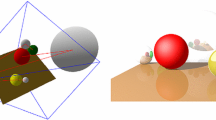Abstract
This paper describes an extension to Fourier-wavelet volume rendering (FWVR), which is a Fourier domain implementation of the wavelet X-ray transform. This transform combines integration along the line of sight with a simultaneous 2-D wavelet transform in the view plane perpendicular to this line. During user interaction, only low resolution images are computed based on wavelet approximation coefficients. When user interaction ceases, the images are refined incrementally with the wavelet detail coefficients. The extension proposed in this paper is similar to a technique called view interpolation, which originates from the field of computer graphics. View interpolation is used to speed up rendering of complex scenes by precomputing images from a number of selected viewpoints. For intermediate viewpoints, rendering is performed by interpolating the precomputed images. In this paper, we show that for FWVR the speed of rendering low resolution images is increased by interpolation of precomputed sets of wavelet approximation coefficients in the Fourier domain. The differences with traditional view interpolation are that (i) interpolation is performed on the wavelet approximation coefficients in the Fourier domain and not on images, and (ii) interpolation is performed during user interaction only. When interaction ceases, ordinary FWVR progressively renders an image at high quality. Medical CT data are used to assess the accuracy and performance of the method. We use regular angular sampling of spherical coordinates which determine the viewing direction. The results show that angle increments as large as 10 degrees result in only a small degradation of image quality.
Similar content being viewed by others
References
S.E. Chen and L. Williams, “View interpolation for image synthesis,” in Computer Graphics(Proceedings of SIGGRAPH 92), 1992, pp. 279–288.
J. Choi and Y.G. Shin, “Efficient image-based rendering ofvolume data,” Journal of KISS, Vol. 26, No. 3, pp. 261–270, 1999.
C.K. Chui, An Introduction toWavelets, Academic Press: Boston, 1992.
R.A. Drebin, L. Carpenter, and P. Hanrahan, “Volume rendering,”in Computer Graphics (SIGGRAPH '88 Proceedings), Vol. 22, No. 4, pp. 65–74, 1988.
M. Frigo and S.G. Johnson, “FFTW: An adaptive software architecture for the FFT,” in Proc. ICASSP, Vol. 3, 1998, p. 1381.
S. Horbelt, M. Unser, and M. Vetterli, “Wavelet projections for volume rendering,” in Eurographics '99, M.A.Alberti, G. Gallo, and I. Jelinek (Eds.), 1999, pp. 56–59.
A.C. Kak and M. Slaney, Principles of ComputerizedTomographic Imaging, IEEE Press: New York, 1988.
R.G. Keys, “Cubic convolution interpolation for digitalimage processing,” IEEE Transactions on Acoustics, Speech, and Signal Processing, Vol. ASSP-29, No. 6, pp. 1153–1160, 1981.
P. Lacroute and M. Levoy, “Fast volume rendering using a shear-warp factorization of theviewing transformation,” in Proceedings of SIGGRAPH '94, A. Glassner (Ed.), 1994, pp. 451–458.
M.Levoy, “Volume rendering: Display of surfaces from volume data,” IEEE Computer Graphics and Applications, Vol. 8, No. 3, pp. 29–37, 1988.
B. Lichtenbelt, R. Crane, and S. Naqvi, Introduction to Volume Rendering,Hewlett-Packard Professional Books, Prentice-Hall: New Jersey, 1998.
L. Lippert, M.H. Gross, and C.Kurmann, “Compression domain volume rendering for distributed environments,” Computer Graphics Forum, Vol. 16, No. 3, pp. 95–107, 1997.
W.E. Lorensen and H. Cline, “Marching cubes: A high resolution 3D surfaceconstruction algorithm,” Computer Graphics, Vol. 21, No. 4, pp. 163–169, 1987.
S.G. Mallat, “Atheory for multiresolution signal decomposition: The wavelet representation,” IEEE Transactions on Pattern Analysis and Machine Intelligence, Vol. 11, pp. 674–693, 1989.
T. Malzbender, “Fourier volume rendering,” ACMTransactions on Graphics, Vol. 12, No. 3, pp. 233–250, 1993.
S. Napel, S. Dunne, and B.K. Rutt,“Fast Fourier projection for MR angiography,” Magnetic Resonance in Medicine, Vol. 19, pp. 393–405, 1991.
F. Natterer, The Mathematics of Computerized Tomography, B.G. Teubner & J. Wiley: New York, 1986.
O. Rioul and P. Duhamel, “Fast algorithms for discrete and continuous wavelet transforms,” IEEE Transactions on Information Theory, Vol. 38, No. 2, pp. 569–586, 1992.
J.B.T.M. Roerdink and M.A. Westenberg,“Wavelet-based volume visualization,” Nieuw Archief voorWiskunde, Vol. 17, No. 2, pp. 149–158, 1999.
T. Totsuka and M. Levoy, “Frequency domain volume rendering,” in Computer Graphics (SIGGRAPH '93 Proceedings), J. Kajiya (Ed.), Vol. 27, 1993, pp. 271–278.
M. Unser, “Splines: A perfect fit for signaland image processing,” IEEE Signal Processing Magazine, Vol. 16, No. 6, pp. 22–28, 1999.
M.Unser, A. Aldroubi, and M. Eden, “A family of polynomial spline wavelet transforms,” Signal Processing, Vol. 30, pp. 141–162, 1993.
M. Vetterli and C. Herley, “Wavelets and filter banks: Theory and design,” IEEETransactions on Signal Processing, Vol. 40, No. 9, pp. 2207–2232, 1992.
M. Vetterli and J. Kova?evi?,Wavelets and Subband Coding, Prentice-Hall: Englewood Cliffs, N.J., 1995.
A.L. Warrick and P.A. Delaney,“A wavelet localized Radon transform,” in Proc. SPIE Vol. 2569, Wavelet Applications in Signal and Image Processing III, Andrew F. Laine, Michael A. Unser, and Mladen V. Wickerhauser (Eds.), 1995, pp. 632–643.
M.A.Westenberg and J.B.T.M. Roerdink, “Frequency domain volume rendering by the wavelet X-ray transform,” IEEE Transactions on Image Processing, Vol. 9, No. 7, pp. 1249–1261, 2000.
M.A. Westenberg and J.B.T.M.Roerdink, “X-ray volume rendering through two-stage splatting,” Machine Graphics and Vision, Vol. 9, No. 1/2, pp. 307–314, 2000.
L.A. Westover, “Footprint evaluation for volume rendering,” Computer Graphics, Vol.24, No. 4, pp. 367–376, 1990.
R.A. Zuidwijk, “The wavelet X-ray transform,” Technical ReportPNA-R9703, Centre for Mathematics and Computer Science, Amsterdam, 1997.
Author information
Authors and Affiliations
Rights and permissions
About this article
Cite this article
Westenberg, M.A., Roerdink, J.B. An Extension of Fourier-Wavelet Volume Rendering by View Interpolation. Journal of Mathematical Imaging and Vision 14, 103–115 (2001). https://doi.org/10.1023/A:1011255130846
Issue Date:
DOI: https://doi.org/10.1023/A:1011255130846




